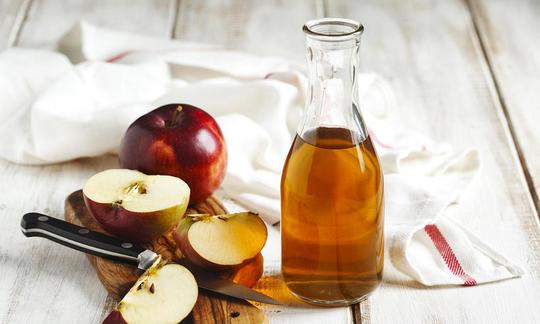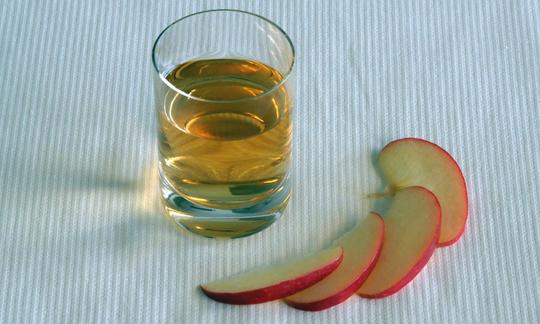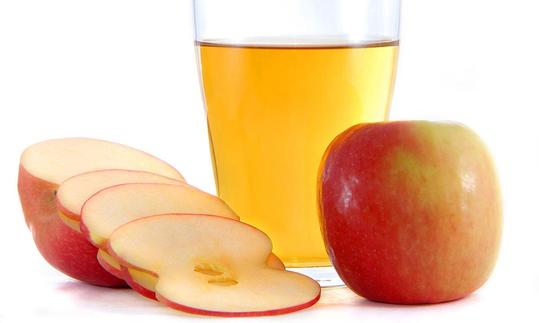Table of contents
The starting products for apple cider vinegar ( organic ) are apple juice or chopped apples ( raw ). Alcoholic fermentation produces apple wine, which is fermented with the help of oxygen to produce fruit vinegar or table vinegar (acetic acid fermentation). The amount of acid (approx. 5%) in apple cider vinegar depends on the original alcohol content.
Using apple cider vinegar in the kitchen:
Apple cider vinegar is very suitable as a base for marinades or dressings and vinaigrettes for salads. This vinegar goes particularly well with raw food, but also as a seasoning for cooked dishes (especially vegetable stir-fries), sauces, dips or chutneys. It is also used as an acidifier for fruit spritzers and lemonades or simply added to normal drinking water . Due to the acid it contains (approx. 5%), apple cider vinegar can be used as a natural preservative, e.g. for pickling vegetables (e.g. gherkins, peppers , zucchini , mixed pickles) or fruit.
Egg substitute: Apple cider vinegar is used as a leavening agent in cakes and baked goods. If you replace 1 egg with 1 tablespoon of apple cider vinegar (and 1 teaspoon of cornstarch and 1 teaspoon of baking soda ), you can achieve vegan quality when baking. If you don't have apple cider vinegar on hand, lemon juice or white wine vinegar are good substitutes for fruit vinegar (fruit vinegar substitute).
If you use vinegar essence as a substitute for apple cider vinegar (e.g. for salads), it must be diluted with at least 4 times the amount of water due to its high acid content (approx. 25%).
Vinegar is a basic ingredient in mustard - along with mustard seeds , water and salt.
Vegan recipe for pointed cabbage salad with apple cider vinegar:
Ingredients (for 2 people): 250 g pointed cabbage, 1 apple (raw, organic), 20 g fresh ginger , ½ teaspoon salt , 2 tablespoons apple cider vinegar (organic), 4 tablespoons apple juice , possibly salt,pepper and 3 tablespoons rapeseed oil .
Preparation: Wash and cut the cabbage into strips after removing the stalk and mix in the salt well. Peel and cut the ginger into small pieces and mix it with apple cider vinegar, apple juice, (salt,) pepper and rapeseed oil. Cut the apple into thin slices, mix it in and add the pointed cabbage. The amount of oil can easily be reduced.
Vegan apple cider vinegar recipe for tomato ketchup:
Ingredients (for 1 liter): 200 g shallots , 2 tbsp rapeseed oil , 80 g brown sugar , 100 g tomato paste , 1 clove of garlic , 50 ml apple cider vinegar (organic), 50 ml red wine vinegar , 1 can of tomatoes , 400 ml tomato juice, salt , 1 bunch of basil , 2 tsp black peppercorns, 2 tsp of another type of pepper (e.g. Timut or Szechuan), 4 tbsp cornstarch .
Preparation: Heat the rapeseed oil in a pan and sauté the chopped shallots with the garlic. Add the sugar and let it caramelize. Stir in the tomato paste and deglaze everything with vinegar. Add the tomatoes and tomato juice, bring to the boil briefly and season with salt. Then let everything cook for 1 hour at a medium heat. After 30 minutes, add the basil leaves. Strain the tomato mixture over a pan and add the cornstarch mixed with water and the crushed peppercorns. Bring the vegan ketchup to the boil again and pour it into small jars while it is still hot. The ketchup can be stored refrigerated for up to a month.
Making tea with apple cider vinegar:
To make an apple cider vinegar drink, pour 2 teaspoons of apple cider vinegar (organic) and optionally 1 teaspoon of honey into a cup of warm water. Using cold water instead of warm water will give you a refreshing summer drink.
The Romans called their non-alcoholic drink made from vinegar and water 'Posca' (but made with wine vinegar).
Vegan apple cider vinegar recipes can be found under the note: " Recipes that have the most of this ingredient ".
| Not only vegans or vegetarians should read this: Vegans often eat unhealthily. Avoidable nutritional errors . |
Shopping - where to buy apple cider vinegar?
Clear apple cider vinegar can be found in all supermarkets such as Coop , Migros , Denner , Volg , Spar , Aldi , Lidl , Rewe , Edeka and Hofer . You can also sometimes get organically produced apple cider vinegar there, naturally cloudy (usually raw). Health food stores, organic shops and organic supermarkets (such as Denn's Biomarkt , Alnatura ), drugstores, specialty stores or online shops often sell different types of organic apple cider vinegar (raw?).
Which apple cider vinegar is the best? / Which is the best apple cider vinegar? If you can choose between clear and naturally cloudy vinegar, you should prefer the cloudy organic version. Organically produced apple cider vinegar contains neither preservatives nor antioxidants and is only filtered through paper. In addition, there is no heat treatment, so naturally cloudy apple cider vinegar (organic) is actually raw food, provided the apple juice used is not pasteurized. Organic products sometimes contain organic caramel sugar to achieve a sweeter note. 11
Industrially produced vinegar is sometimes coloured with caramel colouring (ammonium sulphite colouring, caramel colouring, E150d).
Making your own apple cider vinegar (raw):
Make your own apple cider vinegar: The most important apple cider vinegar ingredients are raw apples - apple scraps or whole organic apples - and water. The surface method (Orléans method) 1 is suitable for household use: For every kilogram of apples you need 2 tablespoons of sugar (optional, the sugar accelerates the fermentation process). Prepare a 1-2 liter, washed or sterilized container and put the chopped apples and sugar in it. Now pour water over it until the apples are well covered and cover it with a clean cloth. The container must now stand like this for a few days. Occasional stirring or swirling increases the oxygen supply and reduces the formation of mold. The resulting foam indicates the beginning of alcoholic fermentation and is normal. After a few days a vinegar smell develops. As soon as this is intense and the apples have sunk to the bottom, pour the liquid through a cloth into another sterile container. Without added sugar, you do this after two weeks at the latest. Then cover the vinegar again and let it ferment for four to six weeks, filter it again through a cloth, fill it into smaller bottles and seal them well. 14
To make apple cider vinegar from apple juice, you leave the natural, cloudy, unpasteurized apple juice covered with a cloth for 4-6 weeks. The apple juice then ferments into alcoholic apple must (cider) and then into apple cider vinegar. If you add a piece of vinegar mother, the process will run faster. 14
The higher the sugar content, the higher the alcohol content, which then disappears again during acetic acid fermentation and shows up in the acid content. If a white layer forms, this can also indicate kahm yeast (wild yeast) (instead of mold). These are skimmed off as best as possible with a wooden spoon so that they do not distort the taste of the vinegar. The rest is stirred in; the acid that is formed neutralizes these yeasts in a natural way. 14
Both homemade varieties can be described as raw and vegan apple cider vinegar - and enjoyed as raw food. This process is not suitable for commercial production, as controlling the fermentation is difficult and incorrect fermentation can easily occur. Read about more suitable processes for larger quantities under "Industrial production". 1
Storage of apple cider vinegar:
Industrially produced apple cider vinegar is usually sold without a best-before date. The production process and the acid content of at least 5% mean that the vinegar is well preserved. However, it should be stored in a clean, well-sealed container in a cool place, protected from light. Homemade vinegar, on the other hand, should be consumed within two years. This is mainly because the production conditions are usually not as sterile as in industrial production. If vinegar shows traces of mold, e.g. due to contamination after opening, you should refrain from consuming it. 2
After some time, a gelatinous "mother of vinegar" can form, but this does not represent a reduction in quality, but rather indicates that the product is particularly natural. These clumped acetic acid bacteria can be filtered out using a sieve. 11
Ingredients - Apple cider vinegar nutritional values - Calories:
In terms of nutritional values, 100 g of apple cider vinegar contains 21 kcal. There are no fats, fiber or proteins. Apple cider vinegar has a negligible amount of carbohydrates (0.93 g/100g) and some salt (13 mg/100g). 3
In terms of nutrients, apple cider vinegar contains 0.25 mg of manganese per 100g, comparable toherbal vinegar (0.25 mg per 100g) or grape juice (0.24 mg per 100g). Agar-agar contains significantly more manganese (4.3 mg per 100g), and red wine vinegar contains less (0.05 mg per 100g). 3
73 mg of 100 g of apple cider vinegar are potassium . Spices such as turmeric (2,080 mg/100g) or paprika powder (2,340 mg/100g) have a very high potassium content, and apple syrup also has significantly more potassium at 735 mg/100g than, for example, rice vinegar (89 mg/100g) or red wine vinegar, which only has 39 mg/100g. 3
The following ingredients are also found in apple cider vinegar: calcium , magnesium , sodium and phosphorus . 3 Fermentation creates new compounds and substances in fruit vinegar. However, the nutrient content is usually reduced compared to that in a fresh, raw apple due to the processing steps.
The complete apple cider vinegar ingredients (table), the coverage of the daily requirement and comparison values with other ingredients can be found in our nutrient tables. In the article Nutrients explained you will get a detailed insight into the topic.
Apple cider vinegar: Health effects - Aspects
There are many different types of vinegar that are said to have health-promoting effects. It is not clear whether apple cider vinegar has a health effect. Such promises of effectiveness are based on studies with very small samples or on animal experiments, the results of which are not always transferable to humans.
Despite many potentially positive effects, there are only a few studies that analyze the types of vinegar on a chemical basis based on their ingredients. A study based on this shows that many ingredients are reduced through fermentation and fermentation processes (e.g. from apple juice to apple wine to apple cider vinegar). Polyphenols (and flavonoids) are therefore more concentrated in fruit and vegetable juices than in vinegar. Minerals and trace elements are present in similar quantities to those in juices, but this is relativized by the low daily intake. The situation is similar with fiber. 7
Another study concludes that various types of vinegar have antibacterial, anti-infective, antioxidant and blood sugar-controlling effects, regulate lipid metabolism and even prevent cancer. The antibacterial and anti-infective effects are attributed to the polyphenols, organic acids and melanoidins contained in the vinegar. The fermentation process mainly produces polyphenols and melanoidins, which are also said to have antioxidant effects. 8
However, the potential effect of acetic acid is better when the body produces it itself (e.g. by consuming raw vegetables and fruit). Acid that gets into the stomach, which is more acidic, cannot have much effect. The acetic acid bacteria usually do not survive the stomach acid and therefore do not reach the intestines, where they could have an effect. 9 In order to make clearer statements here, more studies are needed on the mechanisms of action of apple cider vinegar on the human body. 13
The big advertising promise that apple cider vinegar supports weight loss should also be viewed with some skepticism. Acetic acid is said to have a weight-regulating effect and effects on blood sugar stability and lipid metabolism. 8 There are studies that show positive support for weight loss in mice because their appetite is reduced and so is their weight. 4 The same effect has been demonstrated in obese people who regularly consume apple cider vinegar. 5 However, a feeling of nausea after consuming apple cider vinegar can also curb appetite, although this is not recommended as a "natural" weight loss aid. 6
Dangers - Intolerances - Side effects:
Excessive consumption of apple cider vinegar can be unhealthy, as too much acid is not good for the body. People with sensitive stomachs or existing gastrointestinal problems in particular should use vinegar with caution.
Since the acid in vinegar attacks teeth and tooth enamel, you should always rinse your mouth well after consumption and wait at least 30 minutes before brushing your teeth. 12
Folk medicine - apple cider vinegar naturopathy:
In naturopathy, traditionally produced apple cider vinegar is said to have a variety of effects on health and well-being. It is said to reduce cravings for sweets and generally encourage people to eat less. Vinegar is also said to stimulate digestion and metabolism, cleanse the intestines, relieve heartburn, reduce flatulence, help with diabetes, help against bacteria and fungi (e.g. in the case of cystitis), fight warts, etc.
Occurrence - Origin:
Drinks that taste sour thanks to acetic acid bacteria have been around since ancient times. Not only the Romans, but also the Egyptians, Persians, Greeks and Babylonians produced and drank vinegar. In the Middle Ages, herbs in vinegar were used as a medicine, vinegar was used as a disinfectant and later also as a preservative and stimulant.
Industrial production:
Vinegar (table vinegar) consists of water and acetic acid. During the fermentation process, acetic acid bacteria convert the alcohol from the fruit wine, which has previously been pressed from apples to make apple juice and then fermented to make wine (cider, apple must, sour must), into vinegar. To do this, these bacteria (mainly from the genus Acetobacter ) require oxygen. 15
There are several processes for industrial vinegar production. Fermented vinegar, which also includes apple cider vinegar, is produced almost exclusively using the submerged process (acetator process), as this is quick and inexpensive. The acetic acid bacteria are constantly submerged in the liquid and pure oxygen is added to speed up the process. The advantage of this process is that all parameters can be set precisely and the process is automated. 1
In the trade, a distinction is made between filtered (clear) and unfiltered (naturally cloudy) apple cider vinegar. Unfiltered vinegar still contains the mother of vinegar (a deposit of acetic acid bacteria on the bottom of the bottle). Vinegar is raw if it is unpasteurized and unheated. The apple juice used to make vinegar may be pasteurized. However, since the production of apple juice is only an intermediate step in the vinegar industry, this is rarely the case. Whether the vinegar as a final product is pasteurized or unpasteurized (pasteurization before bottling) must be declared. To be absolutely sure that the product is raw, we recommend making the vinegar yourself, as described above.
In the binding process (quick vinegar process, chip forming process or generator process), the bacteria are bound to a carrier material (e.g. wood chips, plastic beads or, more recently, ceramic shards). These fillers are not constantly in the fermentation medium, but are sprayed over with the material. This means that the acetic acid bacteria are supplied with enough oxygen during the spray breaks and the alcohol content is also very well regulated, which causes fewer faulty fermentations. 1
Commercial vinegar has an acid content of 5-6%. Wine vinegar or spirit vinegar sometimes contains 0.2 to a maximum of 1.5% alcohol by volume.
General information:
Apple cider vinegar is also available as a dietary supplement in tablet or powder form. These products are much more expensive than the liquid version. But here too there is no clear scientific evidence regarding its effectiveness.
Alternative names:
You can also find incorrect spellings such as apple vinegar or search terms such as apple vinegar in English, application of apple vinegar, ingredients apple vinegar pictogram, organic apple vinegar. The last-mentioned term is probably Germanized, based on the English expression organic food (organically produced food / organic products).
In English, apple cider vinegar is called apple cider, apple vinegar or apple cider vinegar, occasionally also cider vinegar. Clear (filtered) apple cider vinegar is called clear apple vinegar and the naturally cloudy apple cider vinegar is called naturally cloudy apple cider vinegar.
Use of apple cider vinegar:
The use of apple cider vinegar is not just limited to the kitchen, it is also often used as a cleaning agent, detergent and sometimes even as a disinfectant. However, vinegar can also damage certain materials. Vinegar should never be used as a cleaning agent on natural stone (the limescale can dissolve), rubber seals, silicone joints or copper. Vinegar is effective as a fabric softener and cleans drains. Highly concentrated vinegar essence (acid content of approx. 25%) is very effective against limescale, but should be handled carefully due to the high acid concentration and thus corrosive effect. Apple cider vinegar is also said to be good for skin and hair 10 and to work against rashes, shaving cuts and dandruff.
Literature - Sources:















Comments